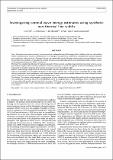Investigating coronal wave energy estimates using synthetic non-thermal line widths
Abstract
Aims. Estimates of coronal wave energy remain uncertain as a large fraction of the energy is likely hidden in the non-thermal line widths of emission lines. In order to estimate these wave energies, many previous studies have taken the root mean squared wave amplitudes to be a factor of sqrt(2) greater than the non-thermal line widths. However, other studies have used different factors. To investigate this problem, we consider the relation between wave amplitudes and the non-thermal line widths within a variety of 3D magnetohydrodynamic (MHD) simulations. Methods. We consider the following 3D numerical models: Alfvén waves in a uniformmagnetic field; transverse waves in a complex braided magnetic field; and two simulations of coronal heating in an arcade. We applied the forward modelling code FoMo to generate the synthetic emission data required to analyse the non-thermal line widths. Results. Determining a single value for the ratio between the non-thermal line widths and the root mean squared wave amplitudes is not possible across multiple simulations. It was found to depend on a variety of factors, including line-of-sight angles, velocity magnitudes, wave interference and exposure time. Indeed, some of our models achieved the values claimed in recent articles while other more complex models deviated from these ratios. Conclusions. To estimate wave energies, an appropriate relation between the non-thermal line widths and root mean squared wave amplitudes is required. However, evaluating this ratio to be a singular value, or even providing a lower or upper bound on it, is not realistically possible given its sensitivity to various MHD models and factors. As the ratio between wave amplitudes and non-thermal line widths is not constant across our models, we suggest that this widely used method for estimating wave energy is not robust.
Citation
Fyfe , L , Howson , T A , De Moortel , I , Pant , V & Van Doorsselaere , T 2021 , ' Investigating coronal wave energy estimates using synthetic non-thermal line widths ' , Astronomy & Astrophysics , vol. 656 , A56 . https://doi.org/10.1051/0004-6361/202141749
Publication
Astronomy & Astrophysics
Status
Peer reviewed
ISSN
0004-6361Type
Journal article
Description
Funding: The research leading to these results has received funding from the UK Science and Technology Facilities Council (consolidated grants ST/N000609/1 and ST/S000402/1) and the European Union Horizon 2020 research and innovation programme (grant agreement No. 647214). IDM acknowledges support from the Research Council of Norway through its Centres of Excellence scheme, project number 262622. TVD was supported by the European Research Council (ERC) under the European Union’s Horizon 2020 research and innovation programme (grant agreement No 724326) and the C1 grant TRACEspace of Internal Funds KU Leuven.Collections
Items in the St Andrews Research Repository are protected by copyright, with all rights reserved, unless otherwise indicated.

